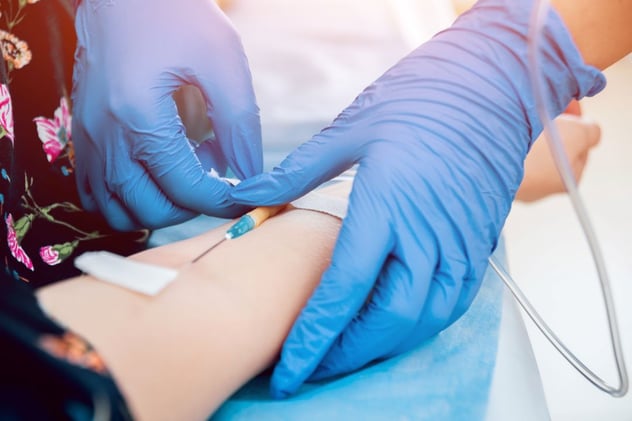
Intravenous therapy (or IV therapy) is a form of treatment in which fluid is delivered into a patient’s veins via an IV drip. IV therapy is frequently used in hospitals and long-term care facilities, typically for patients with severe infections, nutritional deficiencies, serious dehydration, or immune disease. The most frequent uses of IV therapy are:
- Administering antibiotics. IV therapy may be used to treat serious infections like MRSA, C-Diff, and UTIs, or in other cases where the infection needs to be treated as quickly as possible. Because IV therapy allows the medication to bypass the digestive system, it can be absorbed by the body more quickly, and, as a result, is more efficient.
- Providing nutrition. Patients with severely impaired digestive systems may also be fed by IV, in a process known as total parenteral nutrition (TPN). During TPN, the patient is provided with the fluids and nutrients they need via an IV drip to avoid needing to take in food orally.
- Assisting with rehydration. This type of therapy, known as IV hydration therapy, can be a critical component of treatment for many elderly and chronically ill patients.
IV hydration therapy has been in the news as the latest celebrity fad. At so-called drip bars, you can sign up for IV fluids, sometimes blended with vitamins and electrolytes, to treat everything from jet lag to hangovers. Medical professionals are dubious about the efficacy of these treatments for healthy people. However, for ill and elderly patients, IV hydration therapy can be a powerful and efficient remedy for the serious consequences of dehydration.
What Is IV Hydration Therapy?
IV hydration therapy involves administering electrolyte enriched IV fluids directly into the patient’s bloodstream. The process is most frequently used with patients who are suffering from severe dehydration as the most efficient way of introducing fluids by bypassing the gastrointestinal tract.
In most cases, IV hydration therapy is delivered by an intravenous infusion from a drip bag directly into a vein. In some instances, patients may receive fluids via a process called “hypodermoclysis,” also known as a subcutaneous infusion. Hypodermoclysis is less invasive than IV therapy. The fluid is administered via a small-gauge needle just under the skin and can be applied to the upper arms, outer thighs, or abdomen. Hypodermoclysis is most often used in non-emergency situations, as the rate of fluid uptake is slower than via IV.
Causes of Dehydration
Dehydration is a potentially serious condition, in which the body loses more fluid than it takes in. Without sufficient fluid levels, many normal bodily functions begin to fail. The ability to regulate body temperature, as well as the urinary, lymphatic, digestive, and circulatory systems, all depend on adequate hydration.
Mild to moderate dehydration can be remedied by simply drinking more fluids, but severe dehydration will most likely require IV hydration therapy.
Risks of Dehydration
Mild dehydration usually causes increased thirst, a flushed face, cramps, headaches, dizziness, and tiredness. If dehydration is not treated, the patient will usually develop dark urine. The skin will lose firmness—the loose skin on the back on the hands will not sink back into place if pulled. Patients may develop bloated stomachs; a fast, weak pulse; and rapid, deep breathing. Some people may faint or experience muscle convulsions.
Severe dehydration can lead to unconsciousness, decreased blood pressure, confusion, lethargy, and an inability to urinate. If not treated, severely dehydrated patients can die.
Who Is At Risk of Dehydration?
Dehydration can affect anyone, but is more common in the children, people with fevers, athletes, and the chronically ill and the elderly.
Elderly people are more prone to dehydration for a number of reasons:
- The kidneys don’t work as well in the elderly, meaning that more fluids are lost when urinating.
- Elderly people experience a weaker thirst response, meaning that they may forget to drink.
- Some medications frequently prescribed to elderly people can cause an increase in water loss.
- The body retains less water as we age, meaning that older adults have a smaller fluid reserve to draw on.
- Conditions like dementia may make it harder for the elderly to manage their hydration.
Elderly people who are experiencing constipation, kidney problems, or a loss of balance may well be suffering from dehydration.
IV hydration therapy is, therefore, frequently recommended as part of a physical rehabilitation program for elderly people.
Why Is IV Hydration Therapy So Beneficial to the Elderly and Chronically Ill?
IV hydration therapy is a key part of many physical rehabilitation programs, both in skilled nursing centers and in short- and long-term care facilities. This form of treatment can be highly effective because:
- It works much more quickly than oral rehydration.
Dehydration is severely debilitating and potentially fatal. For patients suffering from serious dehydration, IV hydration therapy is the most efficient way to get their fluid levels back up. Because the fluids are introduced directly into the bloodstream, the patient should experience rehydration at a rapid pace.
- It can be helpful for patients who are too weak or ill to drink.
While people who are usually healthy can treat themselves easily by drinking water or a rehydration solution, elderly or chronically ill patients may not have the physical strength to drink enough fluid to treat their dehydration.
It can also be very helpful for patients who are confused—either as a result of the dehydration itself or from dementia. Rather than relying on the patient’s urge to drink, IV hydration therapy provides exactly the amount of fluid the patient needs, quickly and easily.
- It is easily customized to the patient’s needs.
Dehydration can vary widely from patient to patient. The person may be low on electrolytes, fluids, or both. IV hydration therapy allows the patient’s physician to prescribe the appropriate level of fluids, electrolytes, and any additional vitamins or minerals, and ensure that the patient receives the full amount.
At Rehab Select, we offer IV hydration therapy with round-the-clock RN coverage. This enables us to offer multiple dosing schedules. Our rehabilitation specialists work closely with our resident’s primary physicians to ensure that all residents are well hydrated and able to recover fully from the effects of moderate or severe dehydration. To find out more about our services, please visit our website, or click here to contact us.





